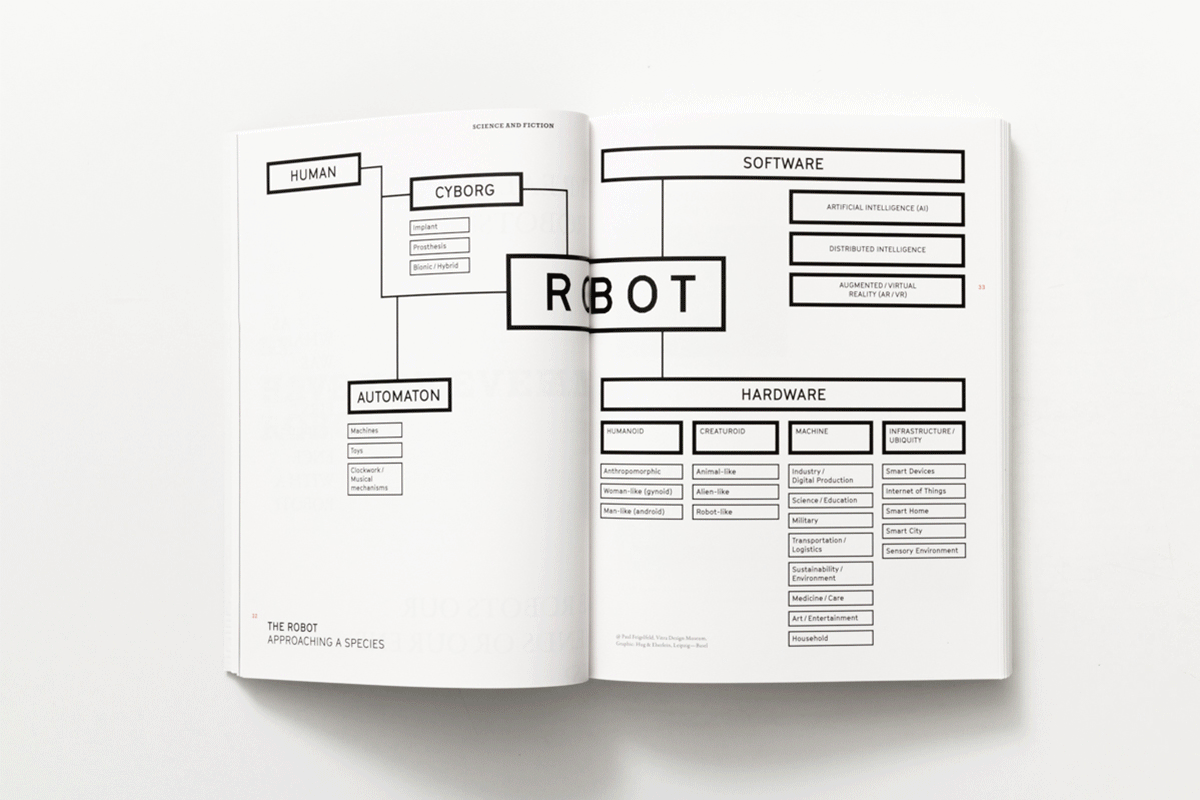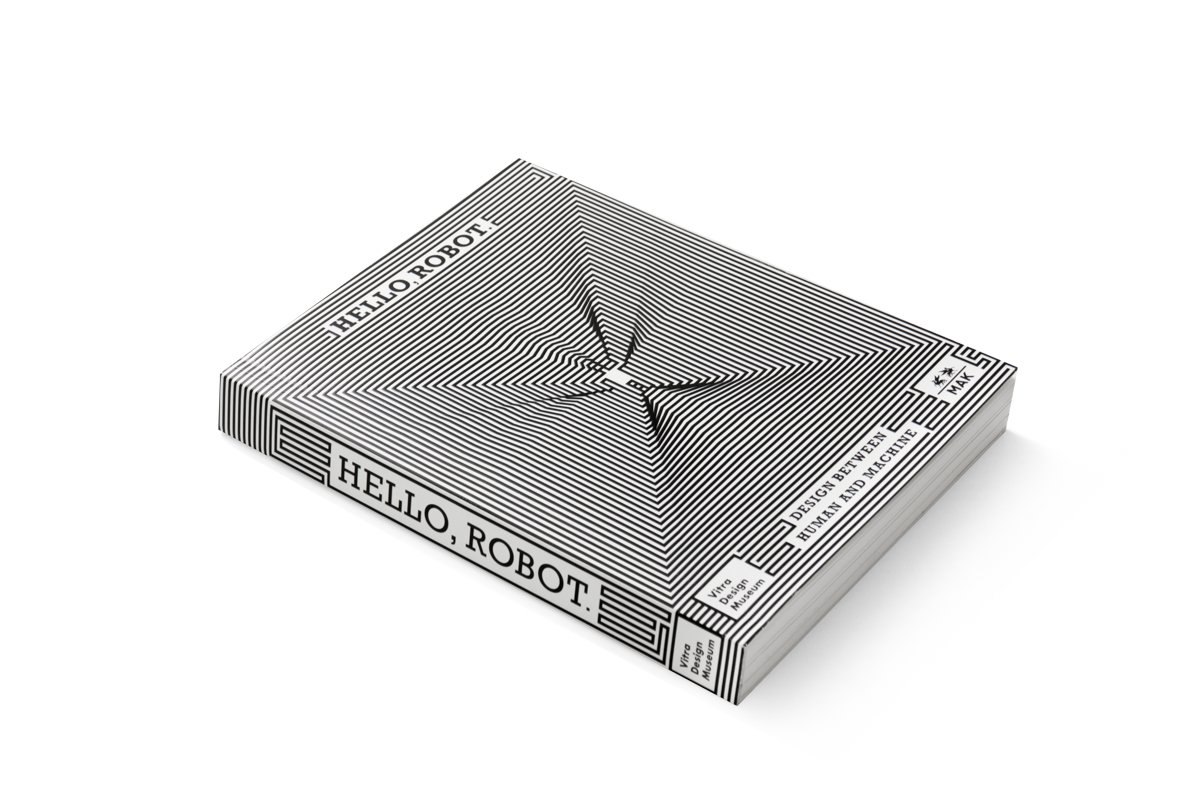THE EXHIBITION ‘HELLO, ROBOT. DESIGN BETWEEN HUMAND AND MACHINE’ HELD AT VITRA DESIGN MUSEUM IN MID-2017 SEEMS TO BE AN ATTEMPT TO SHOWCASE THE MANY ASPECTS OF THE ROLE OF ROBOTS BY THROWING VIEWERS A SERIES OF QUESTIONS AS STARTERS FOR A CONVERSATION TO BE FURTHER ELABORATED UPON.
While there is a rather geeky nature to some of the exhibited items that date back to the beginning 20th century, it’s pretty incredible to know that robots have been in this world for a longer time than one might think. Starting off the narrative with a series of questions makes ‘Hello, Robot.’ speak with its audience in a much more relevant language. Among the number of questions, the one that asks ‘Do you trust robots?’ does reflect a lot of things about the mindsets of people in the past, or even now when a new, unusual invention is created. It also questions the distance we keep between artificial intelligence and ourselves. And with that boundary becoming more and more obscure, the idea of living in a world without technology or machinery feels almost impossible. It’s pretty funny how much the influence of pop culture, movies, cartoons or even games change our perceptions.
After its time at Vitra came to an end, ‘Hello, Robot.’ kicked off its journey as a traveling exhibition with different museums in Europe being its destinations and welcomed the release of the exhibition’s super thick catalogue of the same name. The content of the book, which is divided into four different parts, doesn’t escape that of the exhibition, which is also separated into four sections (Science and Fictions, Programmed to Work, Friend and Helper, and Becoming One). The only difference is probably the articles written by a number of contributors that are featured in the book, which explains why ‘Hello Robot’ has some 300 pages. Looking further, the four sections illustrate the development and different levels of relationships that robots have toward us humans (and vice versa). It begins with the origin of the word ‘robot,’ which was first used on the stage of a play called R.U.R. (Rossumovi Univerzální Roboti) by Karel Čapek back in 1920. The concept of the word implies that a robot is invented solely to serve humans. In movies and cartoons that followed in the decades to come, the image of robots was depicted with the perception that artificial intelligence is not just an enemy but a friend. Then came the time when the possibility of robots replacing the human workforce became a debatable issue (with today’s technology, such idea has been proven possible) or how one would feel if a robot possessed feelings as it manifests the technological evolution that reaches the point where humans and robots actually become homogenized. All of the above are only parts of the entire content of the book, which make us realize the extent of the research the curators must have gone through to cover such a broad and in-depth depiction. Despite our appreciation, we still feel like the very ‘nerdy’ content is so intense that it kind of turns ‘Hello, Robot.’ into a serious textbook, hence, the diminished quality of an interesting read (as an exhibition catalogue).
Another attempt made by the book that we find to be quite intriguing but not as satisfying as it should be is the sentence on the back cover that writes “The layout of Hello, Robot. Design between Human and Machine was devised by an algorithm in collaboration with Double Standard, Berlin.” By intriguing we mean the way in which the layout is executed by a robot (which, in this case, is operated by coding) sounds totally experimental. And by not satisfying, we mean the final result, which isn’t exactly what we would have expected. While the layout, especially the text, is put together in an organized system, as are the images and captions of the pictures, everything seems so scattered that we barely see any indication of what we would expect from a robot-generated layout. While another important question such as to what extent a robot can really replace humans when there’s a factor such as ‘aesthetics’ involved comes to mind, the final answer may not have been given, at least not in this book or the exhibition; but, Double Standard’s experiment with this unique publication does provide us with somewhat of a conclusion that something so abstract like, in this case, the sense of aesthetics, is what differentiates us from artificial intelligence. And even if many differentiations between them and us will eventually disappear in the future, at the very least, we know that when it comes to the matter of ‘aesthetics,’ the robots still have a lot to learn from us humans.
HELLO, ROBOT. DESIGN BETWEEN HUMAN AND MACHINE
Mateo Kries, Christoph Thun-Hohenstein, Amelie Klein (ed.)
Vitra Design Museum, 2017
Paperback, 328 pages, 19 x 24.9 cm
ISBN 978-3-945852-11-8

นิทรรศการ ‘Hello, Robot. Design between Human and Machine’ ที่จัดแสดงที่ Vitra Design Museum ไปเมื่อช่วงกลางปี พยายามจะแสดงให้เราเห็นถึงบทบาทของหุ่นยนต์ (robot) ในมิติต่างๆ ไปพร้อมๆ กับการย้อนกลับมาหาผู้ชมด้วยชุดคำาถามมากมายเพื่อให้เราได้สร้างบทสนทนากันต่อ แม้ว่าเนื้อหาภายในนิทรรศการที่ว่านี้จะค่อนข้าง geeky มากๆ แถมของที่เอามาจัดแสดงนั้นดันย้อนกลับไปไกลถึงต้นศตวรรษที่ 20 อีก ซึ่งไม่น่าเชื่อเหมือนกันที่ไอเดียเกี่ยวกับหุ่นยนต์มันไม่ได้เพิ่งจะเกิดมาเมื่อเร็วๆ นี้อย่างที่เราเคยคิดกันเลย แต่เพราะการเล่าเรื่องด้วยการขึ้นต้นด้วยคำถามแบบนี้เองที่ทำให้เรารู้สึกว่า Hello, Robot. นั้นไม่ได้คุยกับเราในภาษาที่ไกลตัวเท่าไร ในจำานวนคำถามที่ว่านั้น คำถามสั้นๆ อย่าง “คุณเชื่อใจหุ่นยนต์แค่ไหน” ดูจะสะท้อนอะไรหลายๆ อย่างได้ดีเกี่ยวกับความคิดของคนในยุคก่อนที่มีต่อหุ่นยนต์ แล้วก็อาจจะยังมีอยู่จนถึงตอนนี้บ้างเวลาเห็นอะไรแปลกๆ ถูกผลิตออกมาใหม่ ว่าเรานั้นมีระยะห่างกับสิ่งประดิษฐ์จักรกลพวกนี้แค่ไหน แต่ในปัจจุบันกลายเป็นว่าระยะห่างที่ว่านั้นพร่าเลือนไปกับทุกๆ อย่างรอบตัว จนเราแทบจะใช้ชีวิตอยู่โดยปราศจากเครื่องจักรไปไม่ได้เสียอย่างนั้น ตลกดีเหมือนกันที่อิทธิพลของวัฒนธรรมป๊อปจากหนัง การ์ตูน หรือแม้แต่เกมส์ เข้ามาเปลี่ยนความคิดเราได้มากขนาดนี้
หลังจากงานที่ Vitra จบไป พร้อมๆ กับการทยอยเดินสายจัดแสดงต่อไปทั่วยุโรป แคตตาล็อกเล่มหนาเตอะในชื่อเดียวกันกับนิทรรศการก็คลอดตามออกมา เนื้อหาข้างในเล่มที่ถูกแบ่งออกเป็น 4 ส่วนนั้น ไม่ได้หนีไกลไปจากเนื้อหาของนิทรรศการที่ก็ถูกแบ่งออกเป็น 4 โซนเท่าไร คือ Science and Fictions, Programmed to Work, Friend and Helper และ Becoming One จะต่างก็เพียงการใส่บทความโดยนักเขียนจากหลายๆ สาขาเพิ่มเข้าไปในแต่ละ section จนเป็นเหตุผลว่าทำไม Hello, Robot. ถึงต้องหนา 300 กว่าหน้าขนาดนี้ ถ้าสังเกตดีๆ จะพบว่าเนื้อหาทั้ง 4 ส่วนนั้นแสดงให้เราเห็นถึงพัฒนาการ และระดับความสัมพันธ์ที่หุ่นยนต์มีต่อเรา (และเรามีต่อหุ่นยนต์) ได้ชัดเจนอยู่เหมือนกัน คือเริ่มตั้งแต่การพูดถึงต้นตอของคำว่า “robot” ตอนที่มันถูกใช้ครั้งแรกในละครเวที R.U.R. (Rossumovi Univerzální Roboti) ของ Karel Čapek เมื่อปี 1920 เลย ว่าคอนเซ็ปต์ของคำๆ นี้เป็นแค่สิ่งที่ถูกประดิษฐ์มาเพื่อรับใช้มนุษย์เท่านั้น และการที่บรรดาหนังและการ์ตูนหลายๆ เรื่องในยุคต่อมาพยายามสร้างมโนทัศน์ว่าหุ่นยนต์นั้นไม่ได้เป็นแค่ศัตรูแต่ก็เป็นมิตรกับเราด้วย จนถึงยุคที่ความคิดเรื่องว่าหุ่นยนต์จะมาทำงานแทนที่เราได้ไหม (ซึ่งก็เกิดขึ้นแล้วในตอนนี้) หรือเราจะรู้สึกยังไงถ้าหุ่นยนต์มีความรู้สึกถูกยกขึ้นมาพูดถึงไปพร้อมๆ กับแสดงให้เราเห็นว่าวิวัฒนาการของเทคโนโลยีในตอนนี้มันไปไกลจนถึงขั้นที่ว่าเรานั้นสามารถจะกลายเป็นหนึ่งเดียวกันกับหุ่นยนต์ได้แล้ว ที่เล่าๆ มานี้เป็นแค่ส่วนหนึ่งของเนื้อหาทั้งหมดเท่านั้น ซึ่งนั่นทำให้เรารู้ได้เลยว่าทีมคิวเรเตอร์นั้นทำการบ้านมาได้อย่างละเอียดจริงๆ แต่ถึงอย่างนั้น ไม่รู้ทำไมเรากลับคิดว่าความเนิร์ดของเนื้อหาที่มันเข้มข้นมากๆ แบบนี้ มันพาลทำให้แคตตาล็อก Hello, Robot. ขาดความน่าสนใจไป จนน่าจะถูกเรียกว่า “ตำรา” มากกว่าแทน
อีกความพยายามของหนังสือเล่มนี้ที่เราคิดว่าน่าสนใจมากๆ แต่ก็ยังไปไม่สุดเสียทีเดียวคือประโยคบนปกหลังที่ว่า “เลย์เอาท์ของ Hello, Robot. Design between Human and Machine ได้รับการออกแบบโดยอัลกอริทึม ด้วยความร่วมมือกับ Double Standard จากเบอร์ลิน” ที่ว่าน่าสนใจก็เพราะวิธีการจัดหน้าหนังสือว่าด้วยหุ่นยนต์ด้วยการให้หุ่นยนต์เข้ามาช่วยนั้น (ในที่นี้คือการเขียนโค้ดขึ้นมา) มันดูเป็นอะไรที่ experimental มากๆ แต่ที่ว่ามันยังไม่สุดนั้น ก็เพราะผลลัพธ์สุดท้ายที่ได้ออกมามันไม่ได้เป็นในแบบที่เราคิดไว้สักเท่าไร คือเลย์เอาท์ข้างในมีความเป็นระบบชัดเจนในส่วนที่เป็นตัวหนังสือ แต่พอมีภาพและคำบรรยายเข้ามาร่วมด้วยมันกลับถูกวางกระจัดกระจายจนเราแทบไม่ค่อยรู้สึกได้ถึงระบบที่วางไว้ก่อนหน้านี้เท่าไหร่เลย คำถามที่ว่าหุ่นยนต์จะมาทำงานแทนที่คนได้แค่ไหนเมื่อมีปัจจัยอย่างเรื่องของ “ความงาม” เข้ามาเกี่ยวข้องอาจจะไม่สามารถหาคำตอบได้ในตอนนี้ แต่ถึงอย่างนั้นการทดลองของ Double Standard ในหนังสือเล่มนี้ก็ทำให้เราพอจะได้ข้อสรุปบางอย่างว่าของที่มันนามธรรมมากๆ อย่างเช่นในที่นี้คือ การรับรู้ความงาม (sense of aesthetics) นั้นเป็นสิ่งที่ทำให้เรายัง “ต่าง” ไปจากหุ่นยนต์อยู่และแม้ว่าในอนาคตต่อไปไอเดียนี้มันก็อาจจะหายไปด้วยก็ตาม แต่อย่างน้อยเราก็รู้สึกว่า สำหรับหุ่นยนต์นั้น “อะไรคือความงาม” เป็นเรื่องที่เรายังต้องสอนมันอีกเยอะ
TEXT : PAPHOP KERDSUP
PHOTO : KETSIREE WONGWAN
design-museum.de

